abit IP35-Pro: Houston, We Have a Winner
by Gary Key on November 1, 2007 7:00 AM EST- Posted in
- Motherboards
abit IP35-Pro: Board Layout and Features
The abit engineers spent the proper amount of time on the layout of this board. The color scheme is simple and almost elegant when comparing it to some of the Crayola color schemes we have seen in the labs. The board was a snap to install in our Antec P180 and Cooler Master 830 cases with most connections easily reached. The board features a high quality four-phase voltage regulator system that provided excellent stability throughout testing. The board also utilizes Conductive Polymer Aluminum Solid Capacitors.
The IP35-Pro comes with six fan headers (1 x 4-pin, 5 x 3-pin) that provided an excellent balance of cooling options. Control of the individual fan headers is available via the BIOS and the µGuru program within Windows. Each header type has the three options of monitoring and control settings within the BIOS. abit utilizes a well-engineered heat pipe system for cooling the MCH, ICH, and PWM component areas.
Engineering can only take you so far, and unfortunately the execution is not always up to standards. Out of the three boards we tested, two had problems with the heatsink properly making contact on the PWM components and the MCH heatsink was not completely flat. A quick Google search will lead you to a forum user who "fixed" this problem. We tried it on one of our boards and noticed the MCH temperatures dropped 5C while PWM temperatures dropped over 9C when overclocking the board.
Around the CPU socket area, we find an ample amount of room for the majority of cooling solutions. We utilize the stock heatsink/fan in our base testing but also installed several aftermarket Socket-775 cooling solutions such as the Tuniq 120 and Thermalright Ultra 120 eXtreme during our overclocking tests. However, based upon our initial overclocking tests, if a vertical mounted fan in an air cooling unit such as the Tuniq 120 or water-cooling is utilized then additional air cooling will be required on the MCH and PWM areas. In other words, the heat pipe system works best with a downward blowing CPU HSF fan in mind.
The 8-pin ATX power connector is located on the edge of the board behind the PS/2 ports and did not interfere with our various cooling units. It is easy to remove the heat pipe system if you wish to water cool the MCH/ICH chipsets or perform the PWM heatsink mod.
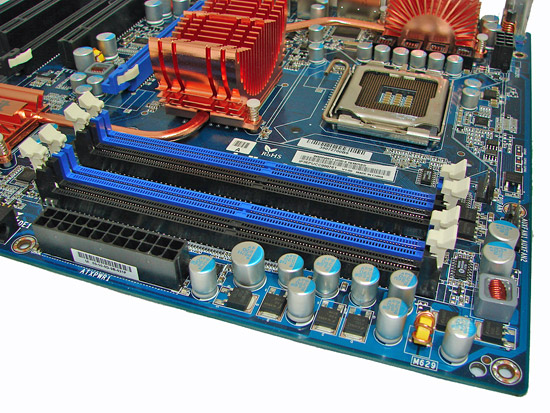
The DIMM module slots' color coordination is correct for dual channel setup based upon the premise of installing DIMMs in the same colored slots for dual-channel operation. Installing memory modules will not be a problem, even with a full-size video card in the first PCI Express x16 slot. The 24-pin ATX power connector is located on the edge of the board along with the number three system fan header.
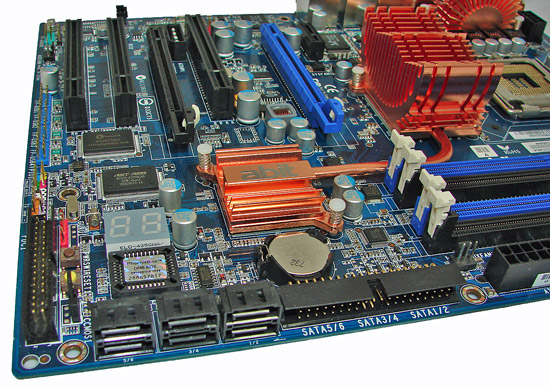
We found the positioning of the six black ICH9R SATA ports to be excellent when utilizing the expansion slots, as they are out of the way of most long cards. The ICH9R chipset uses passive cooling and was reasonably cool to the touch throughout testing. To the right of the SATA ports is the IDE connector and battery.
In a nod to those users who run their systems on an open platform or get tired of hooking up the chassis panel connections, abit has added power on and reset buttons on the board. These buttons have always been useful for us and should be standard on any board in this market segment. Of course, a POST Code Debug LED is included in typical abit style and the floppy drive connector is located next to it.
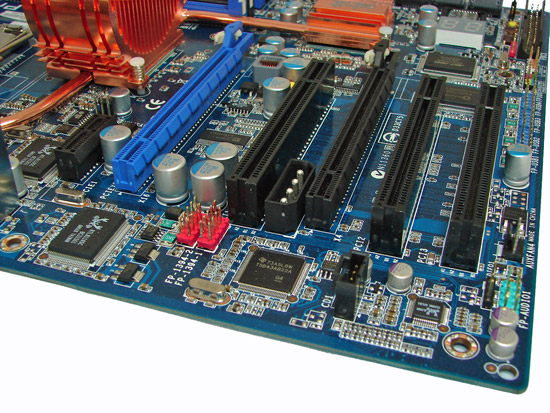
The board comes with two physical PCI Express x16 connectors (1 x16, 1 x4 electrical), one PCI Express x1 connector, and three PCI 2.3 connectors. A dual slot graphics card will block the second PCI slots. Several cards we tried in the PCI Express x1 slot had a tight fit with our 2900XT card installed. A 4-pin 12V Molex connector is to the right of the first PCI slot; CrossFire configurations (or systems where all of the expansion slots are populated) should use this extra power connector.
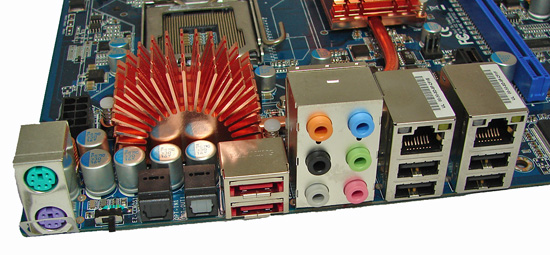
The rear panel contains the standard PS/2 mouse and keyboard ports. The panel also includes two RJ-45 LAN ports with activity indicator lights, four USB ports, and optical in/out S/PDIF ports. The audio panel consists of six ports that support 2, 4, 6, and 8-channel audio connections for the Realtek ALC888 HD codec. Finally, there are two eSATA ports along with a handy clear CMOS switch.
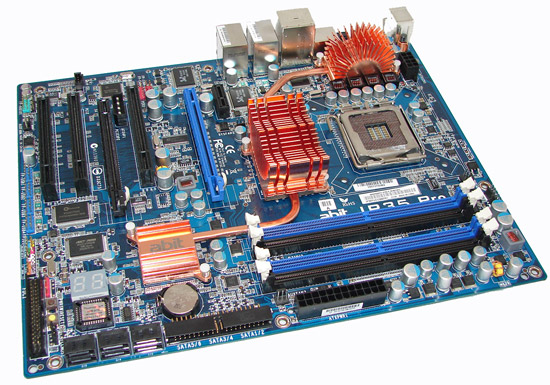 |
The abit engineers spent the proper amount of time on the layout of this board. The color scheme is simple and almost elegant when comparing it to some of the Crayola color schemes we have seen in the labs. The board was a snap to install in our Antec P180 and Cooler Master 830 cases with most connections easily reached. The board features a high quality four-phase voltage regulator system that provided excellent stability throughout testing. The board also utilizes Conductive Polymer Aluminum Solid Capacitors.
The IP35-Pro comes with six fan headers (1 x 4-pin, 5 x 3-pin) that provided an excellent balance of cooling options. Control of the individual fan headers is available via the BIOS and the µGuru program within Windows. Each header type has the three options of monitoring and control settings within the BIOS. abit utilizes a well-engineered heat pipe system for cooling the MCH, ICH, and PWM component areas.
Engineering can only take you so far, and unfortunately the execution is not always up to standards. Out of the three boards we tested, two had problems with the heatsink properly making contact on the PWM components and the MCH heatsink was not completely flat. A quick Google search will lead you to a forum user who "fixed" this problem. We tried it on one of our boards and noticed the MCH temperatures dropped 5C while PWM temperatures dropped over 9C when overclocking the board.
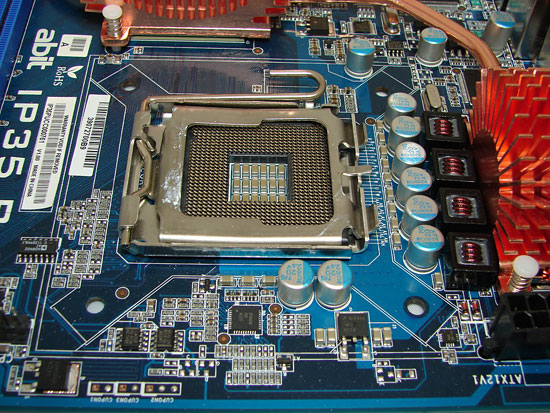 |
Around the CPU socket area, we find an ample amount of room for the majority of cooling solutions. We utilize the stock heatsink/fan in our base testing but also installed several aftermarket Socket-775 cooling solutions such as the Tuniq 120 and Thermalright Ultra 120 eXtreme during our overclocking tests. However, based upon our initial overclocking tests, if a vertical mounted fan in an air cooling unit such as the Tuniq 120 or water-cooling is utilized then additional air cooling will be required on the MCH and PWM areas. In other words, the heat pipe system works best with a downward blowing CPU HSF fan in mind.
The 8-pin ATX power connector is located on the edge of the board behind the PS/2 ports and did not interfere with our various cooling units. It is easy to remove the heat pipe system if you wish to water cool the MCH/ICH chipsets or perform the PWM heatsink mod.

The DIMM module slots' color coordination is correct for dual channel setup based upon the premise of installing DIMMs in the same colored slots for dual-channel operation. Installing memory modules will not be a problem, even with a full-size video card in the first PCI Express x16 slot. The 24-pin ATX power connector is located on the edge of the board along with the number three system fan header.

We found the positioning of the six black ICH9R SATA ports to be excellent when utilizing the expansion slots, as they are out of the way of most long cards. The ICH9R chipset uses passive cooling and was reasonably cool to the touch throughout testing. To the right of the SATA ports is the IDE connector and battery.
In a nod to those users who run their systems on an open platform or get tired of hooking up the chassis panel connections, abit has added power on and reset buttons on the board. These buttons have always been useful for us and should be standard on any board in this market segment. Of course, a POST Code Debug LED is included in typical abit style and the floppy drive connector is located next to it.

The board comes with two physical PCI Express x16 connectors (1 x16, 1 x4 electrical), one PCI Express x1 connector, and three PCI 2.3 connectors. A dual slot graphics card will block the second PCI slots. Several cards we tried in the PCI Express x1 slot had a tight fit with our 2900XT card installed. A 4-pin 12V Molex connector is to the right of the first PCI slot; CrossFire configurations (or systems where all of the expansion slots are populated) should use this extra power connector.

The rear panel contains the standard PS/2 mouse and keyboard ports. The panel also includes two RJ-45 LAN ports with activity indicator lights, four USB ports, and optical in/out S/PDIF ports. The audio panel consists of six ports that support 2, 4, 6, and 8-channel audio connections for the Realtek ALC888 HD codec. Finally, there are two eSATA ports along with a handy clear CMOS switch.










29 Comments
View All Comments
crimson117 - Thursday, November 1, 2007 - link
And if http://forums.anandtech.com/messageview.aspx?catid...">this is the fix, then it's even more complicated than I had expected!Personally, I would RMA a board with this sort of defect present.
takumsawsherman - Thursday, November 1, 2007 - link
I love how these pro boards rarely have Firewire800. It's really a shame that others did not jump on the Gigabyte bandwagon a few years back when they started putting it on their high-end boards. If I remember correctly, they were cheaper than the current crop as well.Of course, I will wager that someone will say that people should use eSATA instead. There are only a few enclosures that have both FW and eSATA, and eSATA is not available on most PC's, and no Macs that I have seen have a eSATA port. I'm not even sure if you can daisy chain eSATA, and I like the FW800 connector better (feels more sturdy). Recently, I looked around for an enclosure to replace one of my old trusty FW400/USB2 enclosures with built in power supply. I ended up not finding the one I wanted, and was very sad, as my requirements were not great.
1. FW800
2. eSATA
3. USB2
4. 5 1/4" drive capacity
5. Built in AC/DC converter (no bricks)
6. Fan if neceaary, I don't care as this is a service drive, not involved with audio
The closest I could get was a NewerTechnology MiniStack V3 from eshop.macsales.com.
1. FW800
2. eSATA
3. USB2, including hub
4. 3.5 inch drives only
5. fan
6. Stupid brick power supply
It cost me $120 empty. It's a great enclosure, meant for stacking under a Mac Mini (and would be awesome for that, though I personally have no mini). There were also the mercury series from OWC at that store, but none had the built in PS, so I figured at that point who cares about 5 1/4.
The end result is that I tried it for a week. It now stays at home. While I used it, I got insane speeds when backing up customer systems over FW800 (Macs doing CarbonCopyCloner clones in a flash, despite the clones being around 30GB. USB2 was as expected (kind of lame), and FW400 was acceptable (but a downer after FW800). For anyone who is interested, the drive I put in it was a Seagate 320 SATA with the crazy SCSI-sized jumper removed. I never got to use eSATA, as I have found no systems that have the port, except one production server that I am not going to test on. I'm sure it's nice and fast.
Of course, with all the back and forth, carrying a brick around is annoying, when previously all I needed to carry was a firewire or usb cable. Of course, this has nothing to do with Abit's board, except that if more boards were made that included FW800, more varieties of enclosures would be available, and someone would make my above list come true.
Gary Key - Saturday, November 3, 2007 - link
I have always been disappointed with the lack of Firewire 800 on the upper end boards but it appears the users requesting it are in a very small minority (which includes me) according to the suppliers. We do have USB 3.0 and Firewire 1600 to look forward late next year. :)sheared - Thursday, November 1, 2007 - link
It should be noted that the Abit forums are, while not full, scattered with threads regarding incompatibilities between this MB and various PSU's. For now at least, you should be careful to select a PSU from a manufacturer that is known to work with the board. I selected a Seasonic thinking that a good, reputable manufacture such as that would have no issues. Wrong. POST code 8.2.Just be careful in the selection, and you'll do fine with this board.
Gary Key - Saturday, November 3, 2007 - link
PSU-We tried everything from a Seasonic S12 II 430W to the OCZ 1000w without a problems including a couple of "inexpensive" 500w power supplies out of generic cases without a problem. We tried to recreate some of the problems that users have noticed and could not with three different boards.
feraltoad - Thursday, November 1, 2007 - link
My X-fi xtreme music works great fortunately, it didn't crackle in my old Asrock DualSATA2 which some people reported as being a problem.I have a ZerDBA psu that works fine and a WD5000AAKS & WD3200KS & 36gb Raptor that works great, no raid though.
I've been very happy with the ip35 pro. I think editors choice is very well warranted. I use the uGuru program to OC in windows! How often can you OC in windows and have it be stable?
My heatsinks were OK, but I have heard some problems but the fix is super easy. Just replace the plastic pushpins in the sinks with bolts. That's an easy fix, sure you shouldn't have to paying that much for a mobo and they need to fix it, but if I had to saddled with a problem and I'm a pessimist(read: realist) and expect things to go bad I would rather have a problem that I can easily fix myself. So really it's a pessimist dream come true even if it comes out as the worse case scenario!
yyrkoon - Thursday, November 1, 2007 - link
there are also scattered reports of the larger Raptor HDDs not working under certain circumstances with these boards, as well WD SE16 HDD issues(mainly with RAID I think), and possible X-FI incompatibilities.ABITs forums though is one good example as to why their products still sold well, despite for having a 'bad rep' compared to other companies. Its these Forums that helps ABIT customers solve, and potential avoid issues with any given product.
For what it is worth, I have read about certain Seasonic PSUs being an issue with these boards, but the PSU I am using; an Antec EA500(EarthWATTS 500) *is* supposed to be built by Seasonic as well . . . it also works very well. However, I am also using the IP35-E, not the Pro.
yyrkoon - Thursday, November 1, 2007 - link
that it is about time you guys did a write up of this board, but I am mystified as to why you guy did not mention the IP35-E(the IP35 Pros 'little brother'). Sure it does not have all the bells and whistles, but on an extreme budget, the IP35-E is very hard to beat.My IP35-E is running an E6550 @ 3.33Ghz with stock cooling and stock voltages, and 100% stable for the last 1.5 weeks or so. Just being able to drop the FSB:DRAM ratio to 1:1, bumping up the MCH one notch, and setting the external clock to 475Mhz makes for very simple overclocking. I have a very hard time imagining any other board being easier than this when overclocking. All this, and superb functionality(everything worked straight out of the box) without updating the BIOS. I can imagine never updating the BIOS, the functionality for me is that good.
Now if I could only fit a thermalright cooler into my case, I would be in 'hog heaven'.
Gary Key - Saturday, November 3, 2007 - link
abit did not supply the IP35-E for review, but we bought one anyway and will show it against the MSI NEO2 and DFI Bloodiron shortly.